By John Koster
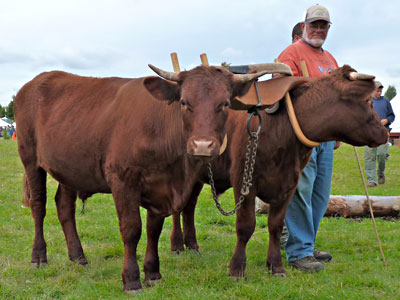 |
| The first Devon cattle were shipped from England to Plymouth Colony in 1623. Here, Wes Daniels is shown with his Devon oxen at the Common Ground Country Fair. English photo. |
Cows are good! Without the predictable supply of milk, meat, leather and fertilizer supplied by domesticated cattle, the great civilizations of the Northern Hemisphere would not have flourished. The original “acre,” in fact, was a measure of the area of land a farmer could plow with a single ox and a wooden plow. Cultures without the ability to plow for cereal crops, in particular, had to keep so many people involved in agriculture, according to the theory of Dr. Jared Diamond, that those cultures never nurtured full-time blacksmiths, weavers, merchants and scholars.
Cows are bad! A United Nations report says cattle farming is “responsible for 18% of greenhouse gases.” The production of cattle, particularly for food, has been cited as one of the three top environmental threats because of deforestation to pasture the planet’s 1.5 billion domestic cattle. (Bad press around cows is countered by Joann Grohman’s article “Why We Need Cows” in the summer 2010 issue of The Maine Organic Farmer & Gardener – at www.mofga.org/Publications/MaineOrganicFarmerGardener/Summer2010/Cows/tabid/1614/Default.aspx)
Debating aside, cattle fostered the development of Western civilization in two ways that people of the 21st century rarely remember: eradication of a disease that once killed multitudes, and the kind of transportation power that horses alone would have been hard pressed to handle.
Cowpox Versus Smallpox
About one in three Europeans who caught smallpox in the 1700s reportedly died, compared with 90 to 95 percent of American Indians who caught smallpox – from Europeans. The far greater survival rate among Europeans enabled the Spanish and the English to overcome otherwise insurmountable odds in fighting formidable warrior tribes such as the Aztecs and Iroquois, men whose fearlessness and stamina would have stopped white invaders in their tracks if the Indians hadn’t been shattered by epidemics. The Europeans’ tolerance was almost certainly due to their exposure to cowpox, a much milder variant of smallpox that almost never killed its victims but almost always rendered them immune to the deadlier smallpox.
The Chinese and the Turks had both developed the “variolization” of people who might be exposed to smallpox, with some success. Chinese physicians had their patients snort snuff made of dried and powdered smallpox pus, and those who survived the treatment were immune for life. Unfortunately, use of actual smallpox pus could sometimes prove lethal in itself.
The English country physician Edward Jenner, although not the first to observe that milkmaids never caught smallpox but usually caught the less serious cowpox, was the first to proceed systematically. On May 14, 1796, he inoculated James Phipps, his gardener’s 8-year-old son, with pus from the cowpox of Sarah Nelmes, a milkmaid who had caught cowpox from a cow named Blossom. The cowpox produced a mild temperature elevation and some minor discomfort but no huge blisters or life-threatening fever. Two subsequent attempts to give poor little James smallpox by smallpox pus failed to produce an infection.
Jenner tested 22 other subjects and said all got mild cowpox but no deadly smallpox. He later admitted that some vaccinated subjects did contract smallpox but the disease was reduced in intensity and seldom if ever fatal.
The humble cow, through Jenner’s experiments – which followed observations of a half-dozen laymen in England and in Germany – led to the near-eradication of smallpox by providing a sort of organic antidote. Napoleon, no admirer of things English, vaccinated his whole Grand Army and sent Jenner a medal. The British government gave Jenner a handsome stipend, banned use of human smallpox in inoculation and began to provide free vaccination with cowpox pus.
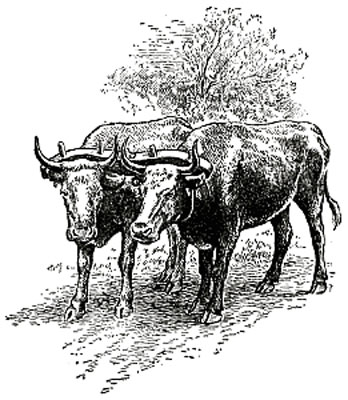 |
| Illustrations from Ox-Team Days on the Oregon Trail, by Ezra Meeker and Howard R. Driggs, World Book Co., 1927. |
Oxen in U.S. History
While cows were helping to exterminate smallpox, their castrated siblings were helping to win the West. Oxen – steers trained as draft animals – had become vital to New England farmers as soon as the first Devon cattle were shipped from England to Plymouth Colony in 1623. Teams of big, squat, sturdy and patient Durham oxen enabled men who had been scholars or merchants in England to become prolific plowmen in New England and New York.
Washington’s Continentals used oxen to tow the British guns they captured at Fort Ticonderoga to beleaguer the Redcoats in Boston, and the huge numbers of oxen that pulled supplies to the American and French armies besieging Yorktown were said to be the largest concentration of bovine critters in early American history. If the horse was the sports car of the 18th and 19th centuries, the donkey was the golf cart, and the mule was the station wagon, the ox was the SUV and pick-up truck, and, in eight-oxen teams, the 18-wheeler.
“Where the march is to extend 1,500 or 2,000 miles, or over rough, sandy, or muddy road, I believe young oxen will endure better than mules,” Captain Randolph B. Marcy wrote in The Prairie Traveler, a manual for settlers who wanted to trek to Oregon, or later to California.
“The ox is a most noble animal, patient, thrifty, durable, gentle, and does not run off,” Peter Burnett, an Oregon Trail survivor, wrote in his own travel’s guidebook. “Those who come to this country will be in love with their oxen. The ox will plunge through the mud, swim over streams, dive into thickets, and he will eat almost anything.”
Wise heads knew that the New England Devons were the best “wheel oxen” – the team to have on either side of the singletree (a crossbar) of the wagon because their steady pace stabilized the load. The front oxen, conversely, were often Texas longhorns because they were tough, fearless, and would charge into difficulties like the Spanish fighting bulls – their distant ancestors – instead of pausing to ruminate, or chew their cud while pondering future action.
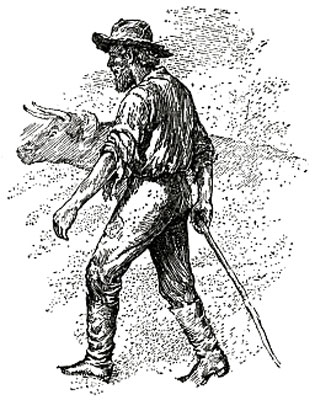 |
People who have worked with oxen know that oxen aren’t especially stupid: They are steered by voice command instead of reins. Oxen generally bond with their drivers. Like most bovines, they seem to prefer adolescent males as drivers or herdsmen – “cowboys” is not an accidental term – but seem to get along with people in general.
Slower than horses, oxen pulled at 2 miles per hour, about walking speed for a human. But they were cheaper – freighters and farmers could generally buy two oxen for the price of a mule, two yoke for the price of a good horse.
Oxen didn’t pull stagecoaches, so they seldom show up in Hollywood Westerns, but the West couldn’t have been won without their work on farms, pulling freighter wagons, and in logging operations, where Paul Bunyan’s blue ox, Babe, was a famous archetype.
Oregon Trail, Take Two
America was forgetting the importance of oxen when Ezra Meeker, a white-bearded authentic pioneer of the 1850s, set out to remind the nation that oxen had played a vital role in the history of the West. Meeker had made and lost a fortune raising hops for the beer industry in Washington state, but was still solvent when, at 77, he decided to travel the route of the old Oregon Trail from West to East and then from East to West – pulled by oxen in a “prairie schooner” he had assembled from scratch, using hardware from original wagons. (Actual pioneers generally used rectangular farm wagons with canvas covers, while only commercial freight carriers used the much bigger boat-bottomed Conestoga wagons and their 8-ox or 12-ox teams.) Oxen were hard to come by in 1906, so Meeker settled for Twist, a 7-year-old with some tugging experience, and Dave, an unbroken 5-year-old range steer. Twist at first adapted better than Dave.
“When we were ready to start, Twist weighed 1,470 pounds and Dave 1,560,” Meeker wrote. “This order of weight was soon changed. In three months’ time Twist gained 130 pounds and Dave lost 80. All this time I fed them with a lavish hand all the rolled barley I dared give and all the hay they would eat.”
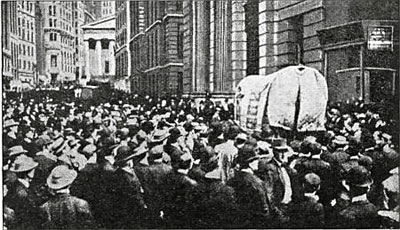 |
Meeker’s trip was a huge success in terms of publicity. Children turned out to sing “Columbia, Gem of the Ocean” and “America” as he planted stone monuments marking the Oregon Trail all over the Pacific Northwest. The old pioneer needed a second team to get his inexperienced oxen through the axle-deep March snow of the Blue Mountains in Oregon, but he drove his oxen through Idaho, reached Fort Laramie and the Platte River in Wyoming, and saw Chimney Rock, a volcanic column and famous trail marker. Disaster struck as Twist, who had gained weight on the sentimental journey, faltered.
“Yesterday morning Twist ate his breakfast as usual and showed no signs of sickness until we were on the road two or three miles, when he began to put his tongue out and his breathing became heavy,” Meeker wrote. “But he leaned on the yoke more heavily than usual and determined to pull the whole load. I finally stopped, put him on the off side, gave him the long end of the yoke, and tied his head back with a leather strap to the chain, but to no purpose, for he pulled by the head very heavily. I finally unyoked, gave him a quart of lard, a gill of vinegar, and a handful of sugar, but all to no purpose because he soon fell down and in two hours was dead.
Meeker, who believed the ox may have eaten some noxious weeds, gave Twist a formal burial with a headboard (a tomb marker made from a board). A half-century before, the pioneers might have done the same, but they also might also have skinned and eaten Twist.
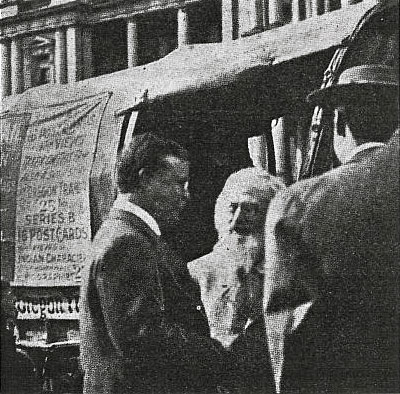 |
Dave couldn’t pull the “prairie schooner” by himself, and Meeker had to rent two-horse teams to get to Lexington, Nebraska, where he looked for but couldn’t find any oxen. He bought two big milk cows, sold one at a loss when it wouldn’t pull, and teamed the more tractable cow with Dave. But the wagon was still pulled by horses except during parade events until, in a lucky moment for both of them, Meeker located a 5-year-old steer named Dandy, whom he rescued from the slaughterhouse stockyards in Omaha. Dandy was about the same age and from the same provenance as Dave. Together they pulled the prairie schooner through parades in Indianapolis, Indiana, in Dayton, Columbus and Cleveland, Ohio, and in Buffalo and Albany, New York.
Meeker needed a special permit to drive the ox team down Broadway in New York City. By this time he was famous, so he got the permit. The prairie schooner was mobbed on Wall Street. Dave and Dandy pulled Meeker across the Brooklyn Bridge. When somebody in Brooklyn stole Meeker’s collie, Jim, the dog was returned when the newspapers posted a $20 reward, no questions asked.
Meeker took the ox team to Trenton, New Jersey, Philadelphia, Pennsylvania, Baltimore Maryland, and Washington D.C., where President Theodore Roosevelt was so excited that he came out of the White House without his hat and asked, “ Where is your ox team? I want to see it!” after Meeker stopped to pay his respects.
Meeker didn’t quite retrace his original 1852 journey from St. Louis to the Pacific Coast. After 28 months on the road, weary and then 78 years old, Meeker had Dave, Dandy, Jim and the “prairie schooner” shipped back to Oregon by rail, where the two stand-in oxen grazed and made public appearances.
Meeker himself convinced Congress to appropriate $50,000 for markers to commemorate the Oregon Trail. He lived to be 98, and by the time he was finally old, Hollywood had started to make feature films about the pioneers and their westward journey. Surprisingly, Hollywood being Hollywood, some of the films even featured oxen.
About the author: John Koster is the author of Operation Snow: How a Soviet Mole in the White House Triggered Pearl Harbor and of Custer Survivor.
